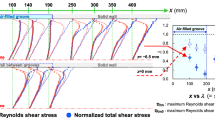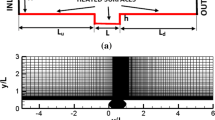Abstract
The studies of bionics reveal that some aquatic animals and winged insects have developed an unsmoothed surface possessing good characteristics of drag reduction. In this paper, four types of bionic surfaces, placoid-shaped, V-shaped, riblet- shaped, and ridge-shaped grooved surfaces, are employed as the microchannel surfaces for the purpose of reducing pressure loss. Lattice Boltzmann Method (LBM), a new numerical approach on mescoscopic level, is used to conduct the numerical investigations. The results show that the micro-grooved surfaces possess the drag reduction performance. The existence of the vortices formed within the grooves not only decrease the shear force between fluid and wall but also minimize the contact area between fluid and walls, which can lead to a reduction of pressure loss. The drag reduction coefficient (η) for these four types of micro-structures could be generalized as follows: ηridge-shaped > ηV-shaped > ηplacoid-shaped > ηriblet-shaped. Besides, the geometrical optimizations for the ridge-shaped grooves, which have the highest drag reduction performance, are performed as well. The results suggest that, for the purpose of drag reduction, the ridge-shaped grooves with smaller width to height ratio are recommended for the lower Reynolds number flow, while the ridge-shaped grooves with larger width to height ratio are be more suitable for the larger Reynolds number flow.
Similar content being viewed by others
References
Li J, Peterson G. P, Cheng P. Three-dimensional analysis of heat transfer in a micro-heat sink with single phase flow. International Journal of Heat and Mass Transfer, 2004, 47, 4215–4231.
Li Z., Tao W. Q, He Y L. A numerical study of laminar convective heat transfer in microchannel with non-circular cross-section. International Journal of Thermal Sciences, 2006, 45, 1140–1148.
Liu D, Garimella S V. Investigation of liquid flow in microchannels. Journal of Thermophysics and heat transfer, 2004, 18, 65–72.
John T J, Mathew B, Hegab H. Experimental analysis of poiseuille number in square microchannels. The Proceeding of ASME International Mechanical Engineering Congress and Exposition, Lake Buena Vista, Florida, USA, 2009.
Schmitt D J, Kandlikar S G. Effects of repeating microstructures on pressure drop in rectangular minichannels. The Proceeding of 3rd International Conference on Microchannels and Minichannels, Toronto, Ontario, Canada, 2005.
Huang C, Gregory J W, Sullivan J P. Microchannel pressure measurements using molecular sensors. Journal of Microelectromechanical Systems, 2007, 16, 777–785.
Wang H L, Wang Y. Flow in microchannels with rough walls: Flow pattern and pressure drop. Journal of Micromechanics and Microengineering, 2007, 17, 586–596.
Wahidi R, Chakroun W, Al-Fahed S. The behavior of the skin-friction coefficient of a turbulent boundary layer flow over a flat plate with differently configured transverse square grooves. Experimental Thermal and Fluid Science, 2005, 30, 141–152.
Wainwright S A, Vosburgh F, Hebrank J H. Shark skin: Function in locomotion. Science, 1978, 202, 747–749.
Bechert D W, Hoppe G., Reif W E. On the drag reduction of the shark skin. The Proceeding of AIAA Flow Control Conference, Boulder, Colorado, USA, 1985.
Bechert D W, Bruse M, Hage W. Experiments with three-dimensional riblets as an idealized model of shark skin. Experiments in Fluids, 2000, 28, 403–412.
Pan G, Guo X J, Hu H B. Numerical simulation of semicircular traveling wave surface and study on its drag-reduction mechanism. Journal of System Simulation, 2006, 18, 3073–3094. (in Chinese)
He X, Luo L S. Theory of the lattice Boltzmann method: From the Boltzmann equation to the lattice Boltzmann equation. Physical Review E, 1997, 56, 6811–6817.
Chen S, Doolen G D. Lattice Boltzmann method for fluid flows. Annual Review of Fluid Mechanics, 1998, 30, 329–364.
Raabe D. Overview of the lattice Boltzmann method for nano-and microscale fluid dynamics in materials science and engineering. Modeling and Simulation in Materials Science and Engineering, 2004, 12, R13–R46.
Niu X D, Shu C, Chew Y T. A lattice Boltzmann BGK model for simulation of micro flows. Europhysics Letters, 2004, 67, 600–606.
Park J, Matsubara M, Li X. Application of lattice Boltzmann method to a micro-scale flow simulation in the porous electrode of a Pem fuel cell. Journal of Power Sources, 2007, 173, 404–414.
Frisch U, Hasslacher B, Pomeau Y. Lattice-gas automata for the Navier-Stokes equation. Physical Review Letters, 1986, 56, 1505–1508.
Yan Y Y, Zu Y Q. A lattice Boltzmann method for incompressible two-phase flows on partial wetting surface with large density ratio. Journal of Computational Physics, 2007, 227, 763–775.
Bhatnagar P L, Gross E P, Krook M. A model for collision processes in gases. I. Small amplitude processes in charged and neutral one-component Systems. Physical Review, 1954, 94, 511–525.
Qian Y H, D’humières D, Lallemand P. Lattice BGK models for Navier-Stokes equation. Europhysics Letters, 1992, 17, 479–484.
Chopard B, Droz M. Cellular Automata Modeling of Physical Systems, Cambridge University Press, Cambridge, UK, 1998.
Guo Z, Shi, B, Zheng C. A coupled lattice BGK model for the Boussinesq equations. International Journal for Numerical Methods in Fluids, 2002, 39, 325–342.
Guo Z L, Zheng C G, Shi B C. Non-equilibrium extrapolation method for velocity and pressure boundary conditions in the lattice Boltzmann method. Chinese Physics, 2002, 11, 366–374.
Zu Y Q, Yan Y Y. Numerical simulation of electroosmotic flow near earthworm surface. Journal of Bionic Engineering, 2006, 3, 179–186.
He X, Zou Q, Luo L S, Dembo M. Analytic solutions of simple flows and analysis of nonslip boundary conditions for the lattice Boltzmann BGK model. Journal of Statistical Physics, 1997, 87, 115–136.
Wang M, Pan N. Modeling and prediction of the effective thermal conductivity of random open-cell porous foams. International Journal of Heat and Mass Transfer, 2008, 51, 1325–1331.
Xin M D, Shi J S. Experiments on forced convective heat transfer performance in rectangular microchannels. Journal of Chongqing University, 1994, 17, 117–122. (in Chinese).
Author information
Authors and Affiliations
Corresponding author
Rights and permissions
About this article
Cite this article
Cui, J., Fu, Y. A Numerical Study on Pressure Drop in Microchannel Flow with Different Bionic Micro-Grooved Surfaces. J Bionic Eng 9, 99–109 (2012). https://doi.org/10.1016/S1672-6529(11)60102-9
Published:
Issue Date:
DOI: https://doi.org/10.1016/S1672-6529(11)60102-9




